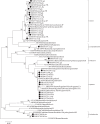Prevalence and diversity of Bartonella species in small rodents from coastal and continental areas
- PMID: 31451710
- PMCID: PMC6710269
- DOI: 10.1038/s41598-019-48715-y
Prevalence and diversity of Bartonella species in small rodents from coastal and continental areas
Abstract
Worldwide, Bartonella infections are known to inflict a wide range of mammals and, within rodents alone, more than 20 Bartonella species have been detected. There is, however, a lack of studies on the presence of Bartonella spp. in rodents in the Baltic region. We analysed 580 individuals belonging to eight small rodent species trapped in coastal and continental areas of Lithuania during 2015-2016. The presence of Bartonella DNA was examined by real-time PCR targeting the ssrA gene. The molecular characterization of the bacteria strains was based on sequence analysis of two housekeeping genes (rpoB, groEL) and the intergenic spacer region (ITS). For the rodents overall, the prevalence of Bartonella spp. was 54.8%, while the prevalence figures for each of the individual species were 8.3% in M. musculus, 15.8% in A. agrarius, 33.3% in M. arvalis, 42.4% in M. glareolus, 53.4% in M. oeconomus, 57.5% in M. minutus, 79.6% in A. flavicollis to 80% in M. agrestis. Sequence analysis revealed that the Bartonella strains belonged to the B. grahamii, B. taylorii, B. rochalimae, B. tribocorum, B. coopersplainsensis and B. doshiae genogroups. The highest Bartonella infection rates and the highest species diversity were both detected in rodents captured in the coastal area. To our knowledge, these are the first reports of the presence of B. coopersplainsensis, B. doshiae and B. tribocorum in Lithuania.
Conflict of interest statement
The authors declare no competing interests.
Figures




Similar articles
-
[Diversity of blood parasites of genus Bartonella in wild rodents in Mazury Lakes District].Wiad Parazytol. 2011;57(1):53-4. Wiad Parazytol. 2011. PMID: 21638804 Polish.
-
Bartonella spp. detection in laelapid (Mesostigmata: Laelapidae) mites collected from small rodents in Lithuania.J Vector Ecol. 2022 Dec;47(2):195-201. doi: 10.52707/1081-1710-47.2.195. J Vector Ecol. 2022. PMID: 36314674
-
Diversity and prevalence of Bartonella species in small mammals from Slovakia, Central Europe.Parasitol Res. 2017 Nov;116(11):3087-3095. doi: 10.1007/s00436-017-5620-x. Epub 2017 Oct 3. Parasitol Res. 2017. PMID: 28975409
-
Molecular phylogeny of the genus Bartonella: what is the current knowledge?FEMS Microbiol Lett. 2001 Jun 12;200(1):1-7. doi: 10.1111/j.1574-6968.2001.tb10684.x. FEMS Microbiol Lett. 2001. PMID: 11410341 Review.
-
Geographical distribution of Bartonella spp in the countries of the WHO Eastern Mediterranean Region (WHO-EMRO).J Infect Public Health. 2024 Apr;17(4):612-618. doi: 10.1016/j.jiph.2024.02.009. Epub 2024 Feb 14. J Infect Public Health. 2024. PMID: 38417187 Review.
Cited by
-
Biomolecular Investigation of Bartonella spp. in Wild Rodents of Two Swiss Regions.Pathogens. 2021 Oct 15;10(10):1331. doi: 10.3390/pathogens10101331. Pathogens. 2021. PMID: 34684280 Free PMC article.
-
Hopping species and borders: detection of Bartonella spp. in avian nest fleas and arctic foxes from Nunavut, Canada.Parasit Vectors. 2020 Sep 14;13(1):469. doi: 10.1186/s13071-020-04344-3. Parasit Vectors. 2020. PMID: 32928287 Free PMC article.
-
Characterization of Bartonella taylorii Strains in Small Mammals of the Turkish Thrace.Ecohealth. 2020 Dec;17(4):477-486. doi: 10.1007/s10393-021-01518-y. Epub 2021 Mar 31. Ecohealth. 2020. PMID: 33788082
-
Bartonella in bat flies from the Egyptian fruit bat in the Middle East.Parasitol Res. 2024 Feb 27;123(2):144. doi: 10.1007/s00436-024-08165-6. Parasitol Res. 2024. PMID: 38411931 Free PMC article.
-
Emerging rodent-associated Bartonella: a threat for human health?Parasit Vectors. 2022 Mar 31;15(1):113. doi: 10.1186/s13071-022-05162-5. Parasit Vectors. 2022. PMID: 35361285 Free PMC article. Review.
References
-
- Jiypong T, Jittapalapong S, Morand S, Rolain JM. Bartonella species in small mammals and their potential vectors in Asia. Asian Pac J Trop Biomed. 2014;4:757–767. doi: 10.12980/APJTB.4.2014C742. - DOI
Publication types
MeSH terms
Substances
LinkOut - more resources
Full Text Sources
Research Materials
Miscellaneous

